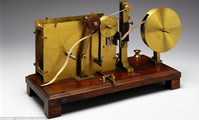








Fax (short for facsimile), sometimes called telecopying or telefax, is the telephonic transmission of scanned printed material (both text and images), normally to a telephone number connected to a printer or other output device. The original document is scanned with a fax machine (or a telecopier), which processes the contents (text or images) as a single fixed graphic image, converting it into a bitmap, and then transmitting it through the telephone system in the form of audio-frequency tones. The receiving fax machine interprets the tones and reconstructs the image, printing a paper copy.Early systems used direct conversions of image darkness to audio tone in a continuous or analog manner. Since the 1980s, most machines modulate the transmitted audio frequencies using a digital representation of the page which is compressed to quickly transmit areas which are all-white or all-black.
Although businesses usually maintain some kind of fax capability, the technology has faced increasing competition from Internet-based alternatives. Fax machines still retain some advantages, particularly in the transmission of sensitive material which, if sent over the Internet unencrypted, may be vulnerable to interception, without the need for telephone tapping. In some countries, because electronic signatures on contracts are not yet recognized by law, while faxed contracts with copies of signatures are, fax machines enjoy continuing support in business.In Japan, faxes are still used extensively for cultural reasons, and are available for sending to both domestic and international recipients from over 81% of all convenience stores nationwide. Convenience-store fax machines commonly print the slightly re-sized content of the sent fax in the electronic confirmation-slip, in A4 paper size.
In many corporate environments, freestanding fax machines have been replaced by fax servers and other computerized systems capable of receiving and storing incoming faxes electronically, and then routing them to users on paper or via an email (which may be secured). Such systems have the advantage of reducing costs by eliminating unnecessary printouts and reducing the number of inbound analog phone lines needed by an office.
The once ubiquitous fax machine has also begun to disappear from the small office and home office environments. Remotely hosted fax-server services are widely available from VoIP and e-mail providers allowing users to send and receive faxes using their existing e-mail accounts without the need for any hardware or dedicated fax lines. Personal computers have also long been able to handle incoming and outgoing faxes using analogue modems or ISDN, eliminating the need for a stand-alone fax machine. These solutions are often ideally suited for users who only very occasionally need to use fax services.
History
Scottish inventor Alexander Bain worked on chemical mechanical fax type devices and in 1846 was able to reproduce graphic signs in laboratory experiments. He received patent 9745 on May 27, 1843 for his "Electric Printing Telegraph."Frederick Bakewell made several improvements on Bain's design and demonstrated a telefax machine. The Pantelegraph was invented by the Italian physicist Giovanni Caselli. He introduced the first commercial telefax service between Paris and Lyon in 1865, some 11 years before the invention of telephones.
In 1881, English inventor Shelford Bidwell constructed the scanning phototelegraph that was the first telefax machine to scan any two-dimensional original, not requiring manual plotting or drawing. Around 1900, German physicist Arthur Korn invented the Bildtelegraph, widespread in continental Europe especially, since a widely noticed transmission of a wanted-person photograph from Paris to London in 1908, used until the wider distribution of the radiofax. Its main competitors were the Bélinographe by Édouard Belin first, then since the 1930s the Hellschreiber, invented in 1929 by German inventor Rudolf Hell, a pioneer in mechanical image scanning and transmission.
The 1888 invention of the telautograph by Elisha Grey marked a further development in fax technology, allowing users to send signatures over long distances, thus allowing the verification of identification or ownership over long distances.
On May 19, 1924, scientists of the AT&T Corporation "by a new process of transmitting pictures by electricity" sent 15 photographs by telephone from Cleveland to New York City, such photos suitable for newspaper reproduction. Previously, photographs had been sent over the radio using this process.